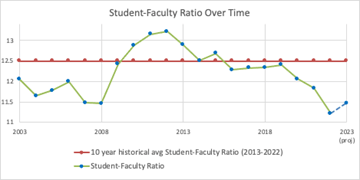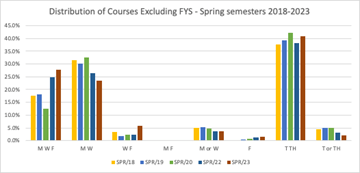
University Academic Plan- Spring 2023
University Academic Plan
Academic Planning Committee
Spring 2023
The Academic Planning Committee [APC] submits this report to the St. Lawrence University community, the President, and the Board of Trustees through the Faculty Council.
INTRODUCTION
In last year’s University Academic Plan [UAP] the APC recommended that the University move from a student:faculty ratio of 11.8:1 back to its ten-year historic average of 12.5:1 by 2024 based on a total projected student enrollment of 2275. We remain committed to meeting the 12.5:1 ratio through attrition rather than by cutting tenured or tenure-track positions. However, the APC’s review of our most current data on total student enrollment shows that the 2022 projection was too optimistic.
It is clear that the uncertain recruitment and retention climate in higher education requires dynamic and flexible modeling and strategic planning. Therefore, the APC’s 2023 University Academic Plan provides our most current data on trends in undergraduate student enrollments and a revised plan for faculty hiring, along with additional recommendations on faculty workload issues and processes to review our curriculum.
Since the 2022 Academic Plan the APC took the first step in moving SLU closer to the student:faculty ratio of 12.5:1 by reducing the number of full-time faculty lines from 196 in 2018 to 190 in 2022. The APC projects a further reduction to 182 full-time faculty lines by 2023.
At the same time, the most current data on undergraduate student enrollment and the number of full-time faculty provided below show that reaching a student:faculty ratio of 12.5 by 2024 would require reductions in the size of the faculty beyond those created by attrition. Such reductions would be disruptive and are not necessary at the moment. Nevertheless, we must continue to work toward a student:faculty ratio of 12.5:1 over a somewhat longer timeline with careful attention to total student enrollment and enrollments in majors, minors, and courses.
For the 2024-2025 faculty hiring cycle pre-requests for tenure-track and visiting positions will be due May 1, 2023. Full requests for tenure-track and visiting positions will be due July 1, 2023.
Other APC initiatives implemented in AY 2022-2023 include the development of a competitive process for granting one-semester course releases, the implementation of a formula to move from 4 to 6 independent SYEs to earn a course release beginning in Fall 2023, the establishment of a minimum course size of 6 students, and a workflow to track courses with lower enrollments. The 2023 Academic Plan contains further details on the implementation of these initiatives.
Finally, the 2023 Academic Plan makes recommendations on furthering our campus discussions of faculty workload issues, the recruitment and training of department chairs and program coordinators, and major/minor curricula concerns in the context of the trends in undergraduate enrollments.
TRENDS IN UNDERGRADUATE ENROLLMENTS AND PROSPECTS FOR FACULTY HIRING
In mid-January 2023, the APC reviewed the latest data on undergraduate enrollment and retention. It was clear that seeing any kind of sustained growth in the size of incoming classes in the foreseeable future is unlikely, given the demographic changes happening in the region and other changes to the higher education landscape that are beyond our control. Challenges in undergraduate student enrollments are not unique to St. Lawrence, and national trends suggest at best flat enrollments out to 2030. These data mean that faculty and staff support for admissions and student retention efforts will continue to be critical to our mission and financial sustainability.
We also must attend carefully to the ratio of enrolled students to full-time faculty as we continue to aim to tie the size of the faculty to overall student enrollment. Tables 1 and 2 below summarize the declines in overall enrollments across class years from 2013 through 2022.
Table 1. Undergraduate Full-Time Equivalency Enrollment at St. Lawrence
|
Fall of: |
UG FTE |
change to prev yr |
On-Campus |
Off-Campus |
|
2013 |
2,401 |
0.8% |
2,257 |
144 |
|
2014 |
2,381 |
-0.9% |
2,220 |
161 |
|
2015 |
2,413 |
1.3% |
2,277 |
136 |
|
2016 |
2,354 |
-2.4% |
2,221 |
133 |
|
2017 |
2,386 |
1.4% |
2,228 |
158 |
|
2018 |
2,419 |
1.4% |
2,278 |
141 |
|
2019 |
2,370 |
-2.0% |
2,238 |
132 |
|
2020 |
2,259 |
-4.7% |
2,259 |
0 |
|
2021 |
2,230 |
-1.3% |
2,148 |
82 |
|
2022 |
2,135 |
-4.2% |
2,011 |
124 |
|
10-yr change |
-266 |
-11.1% |
-246 |
-20 |
Table 2. Undergraduate Full-Time Students by Class Level (On- and Off-Campus)
|
Fall of: |
FY |
SO |
JR |
SR |
|
2013 |
636 |
616 |
586 |
553 |
|
2014 |
613 |
598 |
589 |
569 |
|
2015 |
706 |
550 |
587 |
559 |
|
2016 |
590 |
651 |
541 |
560 |
|
2017 |
711 |
555 |
594 |
510 |
|
2018 |
665 |
632 |
537 |
570 |
|
2019 |
633 |
610 |
588 |
528 |
|
2020 |
599 |
550 |
520 |
580 |
|
2021 |
625 |
552 |
532 |
511 |
|
2022 |
553 |
540 |
502 |
535 |
|
10-yr change |
-83 |
-76 |
-84 |
-18 |
Table 3 shows the latest data on enrollments, numbers of full-time faculty, and student:faculty ratio from 2018, the last year when our student:faculty ratio was close to 12.5.
Table 3. Detailed Student-Faculty Ratio 2018-2022 and Projection for 2023
|
|
2018 |
2019 |
2020 |
2021 |
2022 |
2023 (projected) |
2018- 2022 Change |
2022- 2023 Change (projected) |
|
Undergraduate FTE Enrollment |
2419 |
2370 |
2259 |
2230 |
2135 |
2089 |
-284 |
-46 |
|
Budgeted T/TT lines at UG level* |
174 |
174 |
174 |
174 |
175 |
171 |
+1 |
-4 |
|
Additional visiting FT faculty |
22 |
17 |
13 |
14 |
15 |
11 |
-7 |
-4 |
|
Total Faculty |
196 |
191 |
187 |
188 |
190 |
182 |
-6 |
-8 |
|
Student to Faculty Ratio |
12.3 |
12.4 |
12.1 |
11.8 |
11.2 |
11.5 |
-1.1 |
+0.2 |
Table 4 contains estimated projections of student enrollments each fall through Fall 2026 based on a model of 575 incoming first-year students, 20 transfers, and factoring in current trends in retention, along with gradual reductions in the number of full-time faculty over the same period. These projections for student enrollments are not admissions targets, rather they are estimates of enrollments and concomitant reductions in number of full-time faculty based on current trends. They are shared here as a model of a gradual reduction in the size of the full-time faculty to get us closer to a student:faculty ratio of 12.5:1.
Table 4. Student Enrollment Projections Mapped to the Size of the Full-Time Faculty
Year Enrollment #F/T Faculty S/F Ratio
2022 2,135 190 11.2
2023 (est.) 2,089 182 11.5
2024 (est.) 2,067 177 11.7
2025 (est.) 2,053 173 11.9
2026 (est.) 2,083 169 12.3
To help us further visualize and contextualize these data, in the appendix to this report there are five graphs with longitudinal data on undergraduate enrollments (1975-2022), the size of entering first-year classes of all classes (FR-SR) since 2013, trends in budgeted full-time faculty lines and undergraduate enrollments since 2013, and longitudinal trends in the student:faculty ratio 2003-2023. While we do not have complete data on student retention for this academic year yet, preliminary data indicate that this is a continuing challenge. Faculty and staff, indeed the entire SLU community, all play a role in making our students want to stay here.
Based on these data, and in order to inform the next round of position requests and approvals for the 2024-2025 academic year, we must change the underlying assumptions of our 2022 plan to return to a student:faculty ratio of 12.5:1 over two hiring cycles. We expect it will be necessary to continue to reduce the overall faculty size over the next several hiring cycles due to decreasing student enrollments. Therefore, it is unlikely that the APC could recommend approval of more than three tenure-track positions in the 2024-2025 round of position requests and the approval of new visiting positions will continue to be very tight.
IMPLEMENTATION OF CHANGES TO SYE COMPENSATION
In Fall 2022 the APC devised the last step necessary to implement the shift in SYE compensation from 4 to 6 completed independent SYEs to take account of both those faculty who complete 4 SYEs in AY 2022-2023 and those whose will have several banked SYEs from the current 4:1 policy.
- Anyone who has completed four one-unit independent SYEs by May 2023 will earn a course release under the current policy.
- The APC recognizes that many faculty will have several completed SYEs by May 2023 but will not yet have completed the four SYEs needed to earn a course release under our current policy. Therefore, the APC has devised a formula to convert these completed SYEs to a new scale of 6 SYEs to 1 course release.
In devising this formula, we recognize the following:
- All SYE credits currently earned will be honored. Thus, if you currently have credit for 5 SYEs, you will have earned 1 course release plus one “residual” SYE credit earned. If you have 11 SYE credits currently you will have 2 course releases plus 3 residual SYE credits.
- The residual SYE credits will be rescaled to reflect the new conversion rate of 1 course release to every 6 SYE credits according to the following rules:
- Step 1: Multiply the fraction of a course reduction currently earned at the 1:4 conversion by 6.
- Step 2: Round this result up to the nearest whole credit earned.
- Example: For a person who has currently 1 residual credit in the bank they have earned 1/4th of a course release. Using the steps above we have: 6*(1/4) = 1.50, which is then rounded up to 2. So someone with 1 credit towards a course release in the bank will be credited with having 2 credits for the 1:6 conversion.
This conversion rule for various levels of earned credit (including 0.5-unit SYEs) are summarized in the following table:
Table 5. SYE Compensation Conversion Chart
|
Current Credit Banked |
Fraction of Course Release Earned under the 1:4 rate. |
SYE Credit Conversion |
Converted SYE Credit. |
Remaining SYEs for Course Release |
|
1 |
1/4 |
6*(1/4) = 1.50 |
2 |
4 |
|
1.5 |
3/8 |
6*(3/8) = 2.25 |
3 |
3 |
|
2 |
1/2 |
6*(1/2) = 3.00 |
3 |
3 |
|
2.5 |
5/8 |
6*(5/8) = 3.75 |
4 |
2 |
|
3 |
3/4 |
6*(3/4) = 4.50 |
5 |
1 |
|
3.5 |
7/8 |
6*(7/8) = 5.25 |
6 |
0 |
Beginning in Fall 2023, the number of independent SYEs required for a course release will increase from 4 to 6, corresponding to the minimum course enrollment number of 6 students.
The expiration of SYE course releases will remain in place. Faculty members who have earned a SYE course release will continue to have 10 semesters to use them from the date of the Dean’s office’s notification of the course release.
GRANTING OF ONE-SEMESTER COURSE RELEASES
As noted in the APC University Academic Plan-Spring 2022 and the APC Proposal for Changes in Administrative Procedures-May 2022, the process to apply for and grant one-semester course releases began in Spring 2023, with the first of the new course releases to begin in Fall 2023. The initial call for proposals was announced by e-mail on December 15, 2022 with a deadline for submission of proposals of January 16, 2023. The APC reviewed applications in early February.
BALANCING THE OVERALL COURSE SCHEDULE
The APC Report-May 2021 noted, “Previous research and discussion with chairs in 2019 indicated the need to spread the course schedule out across class time slots using all five available days.”
Starting in Spring 2022 (and following the APC’s specific recommendation), the registrar removed the MW and WF 10:30am-12pm time slot from the calendar and instructed chairs to schedule at least 30% of a department’s introductory-level courses during MWF slots. Preliminary data shows that this has been effective in helping to rebalance the course schedule. In Spring 2022 and Spring 2023, MWF classes make up at least 25% of the total number of courses (see figure below), excluding FYS courses, a significant leap from previous spring semesters. However, the number of TTh offerings remains relatively unchanged over the last five spring semesters. The main change, then, in Spring 2022 and Spring 2023 is that we are offering fewer MW classes and more MWF classes.
Table 6. Course Scheduling, Spring Semesters Only, Last Five Years

We must continue to encourage the use of MWF course times. We will continue to work with chairs of departments with comparatively unbalanced course schedules. There are no additional policy changes in the works, though we ask the Registrar to keep the MW and WF 10:30am-12pm time slots out of the rotation.
REDUCING LOW-ENROLLED COURSES
The opportunity to work closely with faculty in seminars and SYEs is a hallmark of students’ experience at SLU, yet as we noted in our May 2021 report, we must also be mindful of "the very real financial challenges we face.”
Looking at data for Fall 2022, 87 courses, or 18.2% of all courses, had fewer than ten students enrolled. Of these, 24 courses, or 5.0% of all courses, had fewer than six. Our main concern is with courses with fewer than six students; while the APC recognizes that there are several valid reasons for such courses to run, we are concerned when these courses happen frequently and repeatedly.
- In Spring 2023 the APC will review course enrollments over the past five years.
- The APC and the Registrar will work with department chairs and program coordinators on possible changes for courses that have had low enrollments over multiple semesters.
- In April 2023, after registration for Fall 2023 courses, the Registrar will alert chairs to courses that are under-enrolled and ask for changes or an offset plan.
In Fall 2023, the APC will discuss whether any adjustments to this practice need to be made for the next registration period.
FACULTY WORKLOAD ISSUES
The APC is particularly focused on inequities in teaching loads and service obligations. Advising is an additional aspect of faculty workload where there are inequities across campus, but with the current system that allows multiple advisors for each student, it is hard to formulate a reliable method for quantifying actual advising load.
Inequities in teaching load exist both within departments and across the entire campus, and we have discussed a number of metrics that contribute to teaching load, in addition to the simple number of units taught. These include the number of different course preps, the level of the courses taught, and the total number of students taught.
Pedagogies vary so widely across campus that at this point we feel that any single broad policy addressing all of these metrics would be insufficient and potentially harmful. Before any policy recommendation is made, we need additional information about the total number of students taught by individual faculty, how much this number varies within departments, and how much it varies between departments and from semester to semester. The APC is well aware that there will be outliers and semesters when a faculty member is teaching an unusually low or high number of students.
Regarding service obligations, Faculty Council is currently working on committee bloat, and we will endeavor to connect their efforts with our ongoing efforts. The APC has mainly looked at the extent to which certain committees require additional time and work (for example, Faculty Council and the Professional Standards Committee), and chairing those committees requires additional work on top of that. Potential remedies include awarding partial course releases for specific committee service or providing some financial compensation. Before proceeding further, though, the APC needs to examine what compensation policies exist at our peer institutions. The APC will form a subcommittee to do this in Spring 2023.
RECRUITMENT AND TRAINING OF DEPARTMENT CHAIRS AND PROGRAM COORDINATORS
The APC continues to seek a better understanding of: (1) the various ways in which department chairs and program coordinators are selected; (2) the difficulties that chairs, particularly first-year chairs, face; and (3) the different levels of awareness within departments and programs of the tasks of the chair. To this end, in Fall 2022 we distributed a survey to chairs, and will be discussing the survey results in Spring 2023.
In addition, the APC is considering better ways to give voice to those serving for the first time as chairs. For example, a portion of each monthly chairs meeting could be dedicated to those first-time chairs so that they may ask questions and seek advice from those with more experience.
The APC is also debating appropriate ways to recruit, train, and review department chairs and program coordinators.
MAJOR/MINOR CURRICULA CONCERNS
A core purpose of the APC has been to recognize the need to advise about the most effective allocation of academic resources, given institutional financial constraints and enrollments that are likely to decline due to demographic factors. Here we recommend that all departments and programs begin to review their course offerings and major/minor requirements in Spring 2023.
The APC asks that the Dean charge all department and program chairs to conduct a review of their curricula, with the specific goal of identifying:
- challenges faced by students in progressing through the major and identifying the reasons for those challenges (such as course caps, prerequisites, overlap with other required courses, number and/or choice for electives, courses offered inconsistently or only by one instructor);
- courses that consistently have low enrollments, courses where demand continually outstrips supply, and courses that majors have difficulty getting into (for example, popular general education courses).
Departments need to consider whether current major requirements (in terms of number of courses, prerequisites, level of required courses, and specific required courses) are absolutely critical to a depth of understanding of the field for an undergraduate major. Departments should also consider how they would continue to offer a rich and rigorous major if they had fewer courses and faculty, and whether they might want to take such steps irrespective of enrollment or staffing concerns, because of other benefits that might be gained with respect to faculty and student choice.
In early Spring 2023 the APC will provide some guiding questions to begin departmental conversations on their curricula and course offerings. If any department or program would like a member or members of the APC to join them for conversation on these topics, please contact the APC co-chairs so that we can set that up.
Each department will be asked to submit a brief report on their spring conversations to the Dean’s office by May 30, 2023.
Departments also may want to review the major requirements and departmental offerings at peer institutions and/or request an external program review through the Dean’s Office, to stimulate creativity about how the major might be re-envisioned to still achieve its core learning goals in ways that minimize the problems identified and be viable in an environment of diminished resources.
A separate set of major/minor curricular concerns has to do with the creation and dissolution of academic programs. The APC intends to work this year to develop and vet policy and process for considering new academic programs to add to the curriculum, as well as the means by which programs will be assessed in cases where they may be consistently under-enrolled and, ultimately, in rare instances, may not be able to continue among the University’s degrees granted. In our academic planning it would be expedient to have accepted practices for adding new major/minor programs, and logically, therefore, it would also be prudent to have accepted practices for considering the closing of an existing major/minor program.
CONCLUSION
The basic question driving this report, and all of the APC’s work, is: how can we make the most of the limited resources available to us? It is a tricky question in part because those limited resources are we the faculty. The range of answers is inevitably wide. Many of our recommendations have been attempts to answer a variant of that question: how can we organize ourselves most effectively and efficiently to do our work? But efficiency is not the end goal. Ultimately our work must be to continue to create, and create anew, a liberal arts learning environment that is both satisfying to us and inspiring and rewarding for our students.
We welcome your thoughts on this endeavor and this report. You may contact any of the members of the APC listed below or send us comments via the Campus Feedback for APC survey.
Respectfully submitted,
Matt Carotenuto (ADIIS), Brian Chezum (AC-Social Sciences), Alison Del Rossi (incoming VPDAA), Ana Estevez (AC-Natural Sciences) Kimberly Flint-Hamilton (ADDI), Neil Forkey (AC-Interdisciplinary), Elun Gabriel (ADAAP), Sarah Gates (AC-Humanities, Spring 2023 co-chair), David Henderson (AC-Arts, Fall 2022 co-chair), Evelyn Jennings (co-chair, ADFA), Debbie Richards (Registrar), Karl Schonberg (VPDAA), Sam Tartakoff (FC), Jen Thomas (ADFY), Christine Zimmerman (ex-officio, Dir. IR, Assessment Committee)
APPENDIX
Graph 1. Undergraduate Full-Time Equivalency Enrollment, 1975-2022
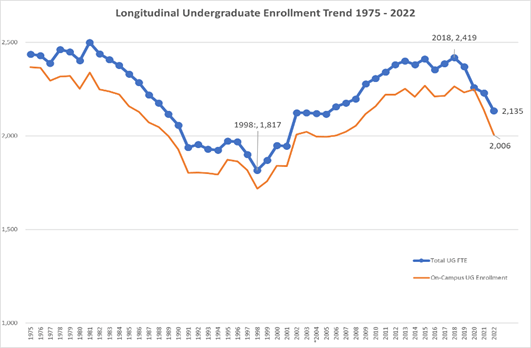
Graph 2. Size of the Entering First-Year Class
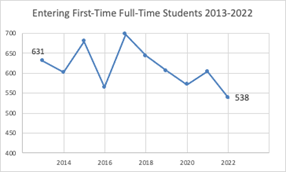
Graph 3. Size of All Classes
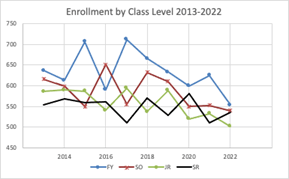
Graph 4. Trend of Budgeted Faculty Lines and Undergraduate Student Enrollment
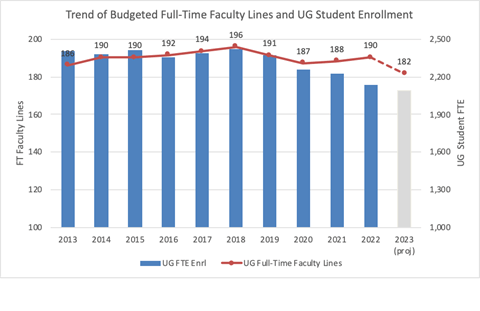
Graph 5. Longitudinal Trend of Undergraduate Student-Faculty Ratio
